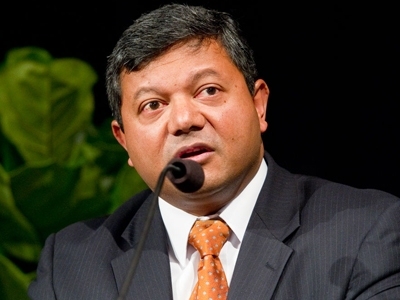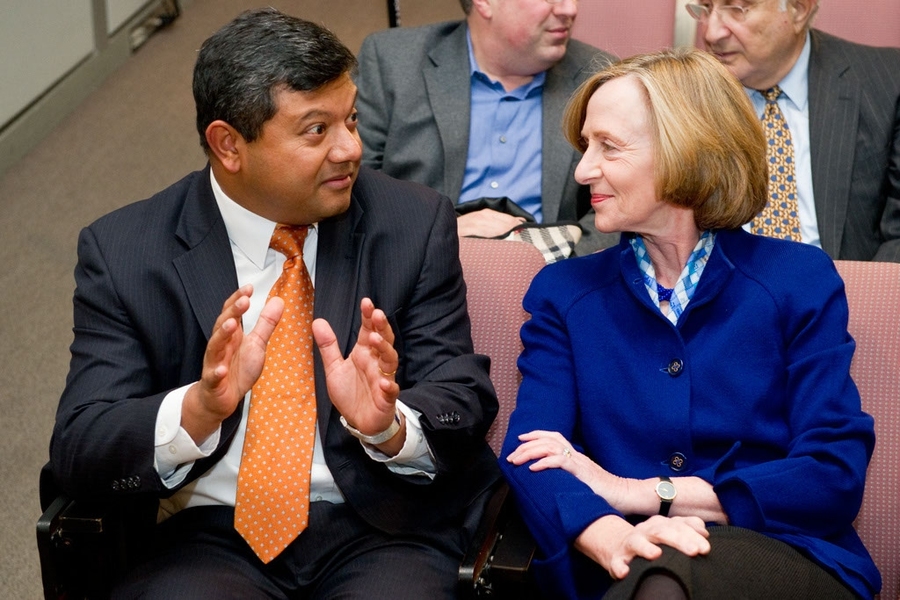During a visit on Wednesday to MIT, Arun Majumdar, director of the U.S. Department of Energy’s Advanced Research Projects Agency – Energy (ARPA-E), discussed the global energy challenge and the role his agency plays in trying to foster transformational energy research and development. Majumdar’s presentation to a standing-room-only crowd in Bartos Theater served as both a wake-up call (the U.S. spends more on dog-food R&D than it does on electrical-power R&D, he noted) and a source of inspiration (Majumdar discussed some of the very real and exciting energy projects his agency is funding, including several here at MIT). After the event, which was sponsored by the MIT Energy Initiative, MIT News asked Majumdar about a surprising new proposal for federal energy-research spending out this week and whether U.S. federal spending should focus more on creating incentives for the adoption and implementation of existing clean-energy technologies and less on basic research.
Q. The American Enterprise Institute, a conservative think tank, and the liberal-leaning Brookings Institution this week announced a highly unusual joint proposal that calls for increasing federal funding for basic research on clean energy from $4 billion to $25 billion. Do you see enough worthy projects on the horizon to justify that degree of spending?
A. You bet. Absolutely. We are totally oversubscribed. The innovation ecosystem — the scientific and engineering community — is ready. They’re just asking how high they should be jumping.
Q. Assuming there would be enough of these projects, how would you see the potential role of ARPA-E in such a program?
A. ARPA-E alone cannot solve the whole energy problem. That’s not its role. There’s a need for basic science — discoveries and tools, etc. — and there’s a need for deployment and supporting technologies that are already here today. ARPA-E’s goal, as I mentioned earlier, is to take the science and translate it into technologies that do not exist today that, should they exist, would make today’s technologies obsolete and that are too risky today for the private sector to invest in.
Q. Some people suggest that new “breakthroughs” in energy technology are not essential, that we already know how to achieve significant reductions in greenhouse-gas emissions, and that federal spending should focus more on incentives for the adoption and implementation of existing technologies than on basic research. How do you address such arguments?
A. I disagree with that. I don’t think they are mutually exclusive. There are technologies today that need to be deployed — there is no question about it — and there are some tax incentives and financial incentives that should be used to create the market and get [the technologies] out. But that does not mean that all the technologies exist today. If someone has said that, they are grossly mistaken. As I said, if you can show me a battery that can make an electric car have the same cost — and the same performance and the same loads and the same range — as an internal-combustion car, show me. I’ll buy it! You cannot. You cannot do carbon capture at a cost that is lower than its price. You cannot make synthetic fuels at a capacity that compares with petroleum at the same cost. You cannot do that today. So the question is not just about today’s technology and getting it out: We are in a globally competitive environment. If we don’t grab that opportunity and develop technologies that will bring down the cost and increase margins, someone else is going to do it.
Q. The American Enterprise Institute, a conservative think tank, and the liberal-leaning Brookings Institution this week announced a highly unusual joint proposal that calls for increasing federal funding for basic research on clean energy from $4 billion to $25 billion. Do you see enough worthy projects on the horizon to justify that degree of spending?
A. You bet. Absolutely. We are totally oversubscribed. The innovation ecosystem — the scientific and engineering community — is ready. They’re just asking how high they should be jumping.
Q. Assuming there would be enough of these projects, how would you see the potential role of ARPA-E in such a program?
A. ARPA-E alone cannot solve the whole energy problem. That’s not its role. There’s a need for basic science — discoveries and tools, etc. — and there’s a need for deployment and supporting technologies that are already here today. ARPA-E’s goal, as I mentioned earlier, is to take the science and translate it into technologies that do not exist today that, should they exist, would make today’s technologies obsolete and that are too risky today for the private sector to invest in.
Q. Some people suggest that new “breakthroughs” in energy technology are not essential, that we already know how to achieve significant reductions in greenhouse-gas emissions, and that federal spending should focus more on incentives for the adoption and implementation of existing technologies than on basic research. How do you address such arguments?
A. I disagree with that. I don’t think they are mutually exclusive. There are technologies today that need to be deployed — there is no question about it — and there are some tax incentives and financial incentives that should be used to create the market and get [the technologies] out. But that does not mean that all the technologies exist today. If someone has said that, they are grossly mistaken. As I said, if you can show me a battery that can make an electric car have the same cost — and the same performance and the same loads and the same range — as an internal-combustion car, show me. I’ll buy it! You cannot. You cannot do carbon capture at a cost that is lower than its price. You cannot make synthetic fuels at a capacity that compares with petroleum at the same cost. You cannot do that today. So the question is not just about today’s technology and getting it out: We are in a globally competitive environment. If we don’t grab that opportunity and develop technologies that will bring down the cost and increase margins, someone else is going to do it.







